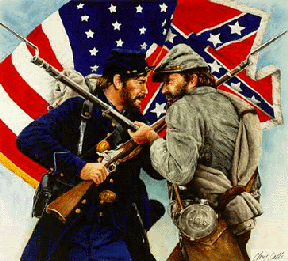 One thing which struck me throughout the docu-drama was the lack of balance in uniforms. I'm not talking about the nit-picking wrong buttons here, but the whole outfit.
One thing which struck me throughout the docu-drama was the lack of balance in uniforms. I'm not talking about the nit-picking wrong buttons here, but the whole outfit.
Union soldiers, practically without exception, were smartly turned out in their blue army uniforms. They might be sweat-soaked and grimy by the finish, but they looked like a solid unit.
In contrast, the Confederates largely looked like they'd just come out of the fields, by-passing a bath in order to get there.
Where were the grey uniforms, which I've seen so much of in actual photographs? Apparently in the wash, because the bulk of the Southerners were clad in an array of different trousers, shirts and waistcoats.
It wasn't that there weren't any grey uniforms at all, but not many. I soon learned to tell the armies apart by whether they were in a uniform (Union) or in their farming clothes (Confederate).
There was also a lot of emphasis upon whether the Confederate under focus owned slaves or not, and if so, how many. Some would say that this was justified, as that was the point of the whole battle. But frankly the documentary didn't establish that, beyond a brief (and highly poignant) scene concerning an escaping female slave.
We weren't similarly told which of the Union officers and soldiers also owned slaves, or supported its institution. There wasn't a single Confederate highlighted who didn't own them (in reality around 52% or less did not own slaves).
Nor was there any mention of the other issues which led to the American Civil War. Nothing there about the states seceding from the Union, and the subsequent Union invasion/reclamation (depending on which side you're on); nor the Morrill Tariff and other protectionism; nor the disparate representation in government; nor the real threat of poverty in the North, if the rich South was allowed to leave.
Ok, I didn't expect more minor issues like the State's Right debate to turn up, but the rest were quite big.
Instead we were left with a vague feeling that it was something to do with slavery; and the South were the only slave owners and they were prepared to protect that with their lives. Without putting on the proper uniforms.
However, other commentators have argued that the Confederate stories were the most moving. While the Union stories tended to be all-action, testosterone fests, without the same emotional depth.
Frankly, as an independent observer, that wasn't my enduring impression at all. They all tugged at my heart-strings!



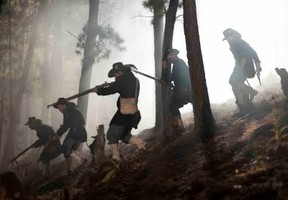 Tony and Ridley Scott set out to create a cinematic style docu-drama, which would interest people who wouldn't normally know or care about historical events.
Tony and Ridley Scott set out to create a cinematic style docu-drama, which would interest people who wouldn't normally know or care about historical events. 

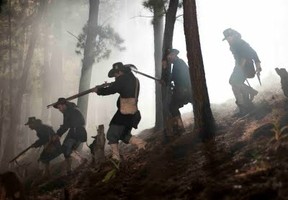 Let me first say that I'm not an expert on this battle. I'm an historian, but I'm more use tearing to pieces a battle in Britain, than in the USA.
Let me first say that I'm not an expert on this battle. I'm an historian, but I'm more use tearing to pieces a battle in Britain, than in the USA.


 One thing which struck me throughout the docu-drama was the lack of balance in uniforms. I'm not talking about the nit-picking wrong buttons here, but the whole outfit.
One thing which struck me throughout the docu-drama was the lack of balance in uniforms. I'm not talking about the nit-picking wrong buttons here, but the whole outfit.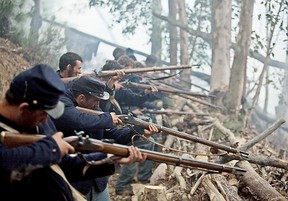







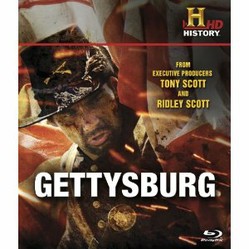

 St Tydecho's Churches in West Waleson 09/03/2014
St Tydecho's Churches in West Waleson 09/03/2014
 Goodies for an Outlander Premiere Partyon 03/06/2015
Goodies for an Outlander Premiere Partyon 03/06/2015
 Holocaust Memorial Day Interview with Rainer Höss, Grandson of Rudolf Architect of Auschwitzon 01/24/2015
Holocaust Memorial Day Interview with Rainer Höss, Grandson of Rudolf Architect of Auschwitzon 01/24/2015
 Romantic Valentine Gifts for an Outlander Fanon 01/16/2015
Romantic Valentine Gifts for an Outlander Fanon 01/16/2015

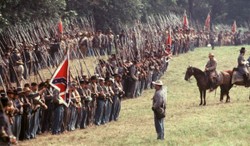
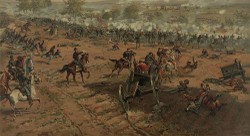
Comments
Would you recommend this documentary?
Yes, the horror often does get lost under crowing about the glory. That's the pity of war, because then it does keep on happening over and over again.
I watched this, too. I've read so much about Gettysburg--it is a true horror story, particularly the aftermath, the suffering of the injured soldiers and what was left for the people of the town to deal with when the soldiers moved on. Difficult topic, but important to remember so history does not repeat itself when we argue over political differences.